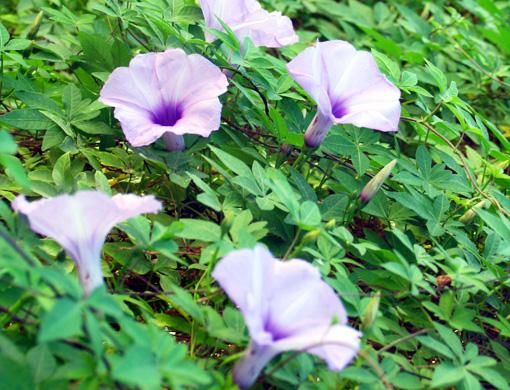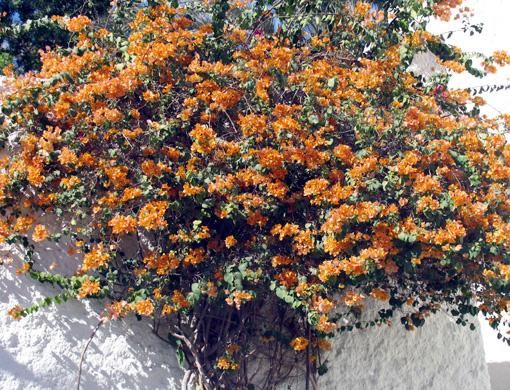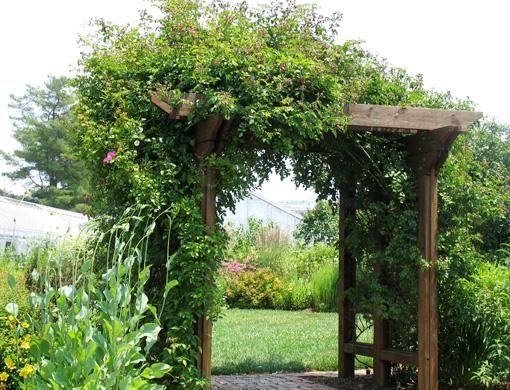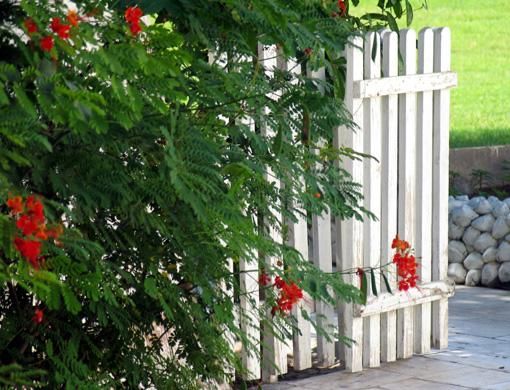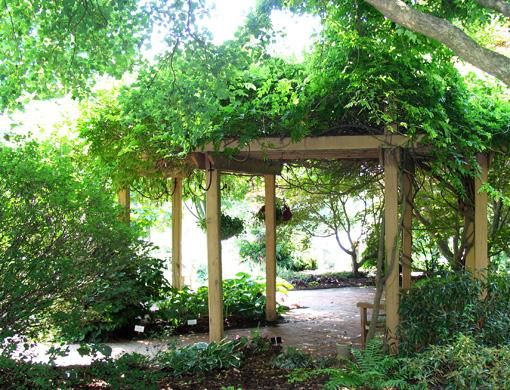When it comes to giving instant height to a garden, there is nothing to beat climbers and vines that will twine around any support to reach skywards.
If you have a relatively new garden without many trees or shrubs to give it the vertical dimension, then you should probably explore the option of growing vines and creepers over free-standing structures such as arches, trellises and pergolas in your garden. Draped in fast-growing climbers, these structures will give your garden maturity beyond its years.
For that matter — any structure that will provide support to a climbing vine including stone walls, pillars, fences, or gates can become solid backdrops to highlight the flowers and foliage.
Invaluable for providing shade, privacy and height, climbers hold a special place in landscaping, especially where space is limited. Even those who live in apartments can grow climbers in a variety of containers to add height to their balcony gardens and create a genuine country look.
A tiny garden can feature attractive flowering vines in many spots — over the balcony railings, fences, gates and arches. Some climbers such as ivy or asparagus fern can be effectively used to cover walls or for framing a doorway.
Vines that produce abundant fragrant flowers such as the Rangoon creepers, jasmine, Japanese honeysuckle etc., can be grown on a simple arched arbour to create an enchanting entryway into your garden.
On the other hand, robust vines such as the trailing vernonea or bougainvillea with their cascading masses of shoots and blooms can be left hanging from high stone walls or compounds to make arresting focal points.
Cool canopies
In a place like the UAE, where shade is a valuable commodity, climbers are indispensable for creating cool canopies along the paths. Vines with dense foliage are like living screens — they create secluded, shady oasis in your garden, providing the same degree of privacy as a tall shrub, without taking up too much ground space.
Vines over trellises can also be effectively used to cover a pock-marked wall or to hide an unsightly garage or any other eyesore around your garden.
Fast-growing vines, including the railway creeper, Rangoon creeper, coral creeper, vernonia etc., grow with rampant abandon and can cover a pergola or an arbour in a short time, shading a patio or walkway more quickly than a tree could. The railway creeper is particularly reliable for creating cool canopies. Trained over a trellis or chicken wire, this evergreen creeper, with its masses of rich green foliage dotted with purple funnel-shaped blooms, presents a cool sight on hot afternoons.
Another fast growing ornamental vine well-suited for covering fences, walls and pergolas, is the coral creeper (Antigonon), which climbs with the help of coiled tendrils and produces pretty sprays of delicate pink blossoms.
The ubiquitous bougainvillea, of course, is one of the most conspicuous and colourful climbers in this region, thriving in full sun and producing masses of vibrant flowers under low water conditions. The showy scarlet, magenta, orange or white bracts create dramatic contrasts against walls and fences. Easily grown from branch cuttings, bougainvillea is a vigorous vine that once established, can ramble up an arch or pergola with the help of its spines.
On the other hand, a twining vine such as the Rangoon creeper climbs by coiling itself around a support — give this woody creeper a pillar or a trellis on a sunny porch, and it will scale great heights in no time. With its hanging clusters of brilliant pink and white blossoms, the quisqualis makes an eye-catching patio plant. It thrives in sunny locations and has a delicate night-time fragrance, making it an ideal climber for arbours, pergolas and gazebos.
Apart from the regular perennial vines, you can also grow annual climbers such as sweet pea, nasturtium, morning glory etc., on fences and trellises with some fascinating results. Many climbing garden vegetables such as gourds, beans, peas, squashes etc., can also be easily trained up arches and pergolas to provide shade. Their hanging crops make a decorative feature in the garden.
Indeed, a bower of climbers makes a wonderfully old-fashioned focal point for any yard aspiring to be a cottage-style garden.
Varieties: What you can grow in the UAE
Here's a list of some popular climbers that can be successfully grown in the UAE climate:
For sunny locations: Asparagus fern (Asparagus setaceus), bougainvillea, coral creeper (Antigonon leptopus), Rangoon creeper (Quisqualis indica), railway creeper (Ipomoea palmata), Cape honeysuckle (Tecomaria capensis), vernonia etc.
For partial shade: Jasmine (Jasminum grandiflorum), Japanese honeysuckle (Lonicera japonica), golden trumpet (Allamanda species), Jacquemontia etc.
For shaded locations: Pothos, Ivy, Philodendrons etc.
Climbers for containers: Bignonia purpurea, Bougainvillea, Butterfly pea (Clitoria ternatea), heavenly blue morning glory (Ipomea coerulea), nasturtium (Tropaeolum majus)
Climbers for fragrant flowers: Jasmine (Jasminum grandiflorum), sweet pea (Lathyrus odoratus), Rangoon creeper (Quisqualis indica) etc.
Structures: Choose from trellises, arches or pergolas
Does your balcony or backyard broil in the afternoon sun? You can fix a trellis as a roof or a screen over a sunny area to provide the much-needed shade. Filled with fast-growing climbers, a trellis creates an airy shelter with dappled shade in a garden.
A trellis is usually a lattice of light wooden or metal bars used to support creepers and vines. Trellises range from inexpensive, wall-fixed wooden panels to highly ornate and costly wrought iron or steel structures. Metal trellises are not viable options in the UAE's hot climate and therefore, most local garden centres sell wooden trellises.
However, whether it's a trellis, pergola or an arch — you must ensure all wooden structures in your garden have been treated with thermo-shield to make them resistant against the onslaught of the strong UV rays. They also must be pressure treated with non-toxic preservatives to provide long-term protection against rotting.
One of the most versatile features in the garden, trellises can serve both decorative as well as practical purposes. Fixing a large trellis to a low wall will provide instant privacy once it is covered with dense foliage. You can also fix a trellis to the railings of the staircase and grow fragrant climbers over it.
A trellis can also be used to shelter a path between the main house and an outbuilding.
An arch is a decorative feature that serves as an eye-catching focal point while supporting a wide array of climbing plants. An arch can also be used to frame a view such as a garden statue or a fountain. Arches can be rounded, pointed or flat.
Brick and stone arches create a strong sense of permanence, whereas softwood arches impart a rustic look to the whole setting. A simple and inexpensive arch can be made using tall trellis panels fixed to sturdy posts.
A pergola is a more elaborate structure, usually extending over paths to create an arbour or a covered-walk. Traditionally used for growing vines in Italy, pergolas are now increasingly used in gardens as decorative elements serving practical purposes. Their open aspect makes pergolas especially suitable for small yards, where solid structures such as walls or fences would create a congested, walled-up setting.
Covered with a canopy of foliage and flowers, tall pergolas break the monotony of a flat canvas by adding height to the garden. When planted with scented climbers, pergolas make cool, fragrant gateways, linking different parts of the garden and creating secluded areas. All you need is a comfortable garden bench under this breezy shelter and you can spend hours relaxing under its fragrant shade.
Tips: Watch where you plant the climbers
You need to plan the positions of climbers in your garden very carefully, because it is not simple to rectify any mistake once the plants have covered the walls or arches. However, given adequate care, climbers will work extra hard to provide shade and privacy. According to M. Vijay Kumar, landscaping engineer, Global Irrigation and Landscaping, Sharjah:
A fully grown average climber may need 8-9 litres of water everyday in winters and about 15 litres of water in summers.
Apart from daily watering, climbers also need fertilising every 3 months.
Vines need regular pruning to keep them in proper shape.
It is also a good idea to aerate the soil around the climber.
Most flowering climbers thrive in sun, but a few such as jasmine, Japanese honeysuckle, jacquemontia etc., grow well in partial shade. Some popular indoor climbers such as Scindapsus (pothos) and ivy can be grown outdoors in cool shade. When grown outdoors, pothos twines around tree trunks to produce large variegated leaves.
Ivy and pothos, which climb with the help of small aerial roots, may need a little assistance initially to help them stick to smooth surfaces. You can use waterproof adhesive tape to gently affix the shoots to the walls. However, it is important to remember these rootlets can permanently damage a wall or wooden panels and therefore, it is advisable to use trellises to make these climbers grow on a wall.
Scented climbers such as jasmine, Rangoon creeper etc., should be grown around doors, windows, gazebos, patios and other sitting areas for maximising their fragrance.
One smart way of packing more plants into a small place is to grow vines over shrubs or small trees. For example, when left to ramble through a shrub, a vine like bougainvillea will give its host plant the appearance of being in constant bloom.


